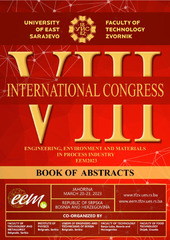Prikaz osnovnih podataka o dokumentu
Optimization of lindane sorption from aqueous solution by macroporous copolymer using experimental design
| dc.creator | Tadić, Tamara | |
| dc.creator | Bulatović, Sandra | |
| dc.creator | Marković, Bojana | |
| dc.creator | Nastasović, Aleksandra | |
| dc.creator | Ilić, Mila | |
| dc.creator | Vuković, Zorica | |
| dc.creator | Onjia, Antonije | |
| dc.date.accessioned | 2023-12-27T12:56:13Z | |
| dc.date.available | 2023-12-27T12:56:13Z | |
| dc.date.issued | 2023 | |
| dc.identifier.isbn | 978-99955-81-44-2 | |
| dc.identifier.uri | http://TechnoRep.tmf.bg.ac.rs/handle/123456789/7050 | |
| dc.description.abstract | In the present study, synthesized macroporous copolymer was used for the sorption of lindane from an aqueous solution. This organochlorine pesticide is classified, according to US EPA, as mutagenic and teratogenic. Residues of lindane can persist in the environment, migrate long distances, and cause widespread contamination. In this way, lindane residues can reach the human body through the food chain. The usage of this pesticide is banned in most countries. However, lindane remains a serious toxicological problem at industrial sites where lindane was used coupled with improper wastewater disposal and has led to serious contamination. In addition, some countries still allow the production and use of lindane, and despite localized restrictions, lindane contamination remains a global problem. Taking into account these reasons, its removal from the environment is of a great significance. The obtained macroporous copolymer was syntesized via suspension copolymerization and was characterized by Fourier transform infrared spectroscopy (FT-IR), and scanning electron microscopy (SEM). The parameters which affect sorption efficiency of the lindane were: pH, sorption time (tsor), ion strength (ion), rpm, and dose of sorbent. These variables were optimized by the experimental design which include Plackett-Burman Design (PBD) and Central Composite Design (CCD). After screening step by the PBD, the optimum conditions were obtained by the CCD where the values were investigated in two levels. The design of experiment showed that the ion strength and dose of sorbent were the most significant parameters, while the other variables do not have such an effect on sorption efficiency. Accordingly, the optimum conditions to reach the maximum recovery were: pH 8, 180 min sorption time, 300 rpm, 2 w/v % ion strength and 8 g/l dose of sorbent. The results showed that the studied copolymer could be an efficient sorbent for trace lindane in water with recoveries above 80 %. | sr |
| dc.language.iso | en | sr |
| dc.publisher | Zvornik : Faculty of Technology | sr |
| dc.rights | openAccess | sr |
| dc.rights.uri | https://creativecommons.org/licenses/by/4.0/ | |
| dc.source | Book of Abstracts / VIII International Congress "Engineering, Environment and Materials in Process Industry", Jahorina, March 20-23, 2023 | sr |
| dc.subject | organochlorine pesticide | sr |
| dc.subject | design of experiment | sr |
| dc.subject | DoE | sr |
| dc.subject | macroporous copolymer | sr |
| dc.subject | optimization | sr |
| dc.title | Optimization of lindane sorption from aqueous solution by macroporous copolymer using experimental design | sr |
| dc.type | conferenceObject | sr |
| dc.rights.license | BY | sr |
| dc.citation.spage | 124 | |
| dc.identifier.fulltext | http://TechnoRep.tmf.bg.ac.rs/bitstream/id/19324/EEM2023_Abstract_Lindane.pdf | |
| dc.identifier.rcub | https://hdl.handle.net/21.15107/rcub_technorep_7050 | |
| dc.type.version | publishedVersion | sr |

